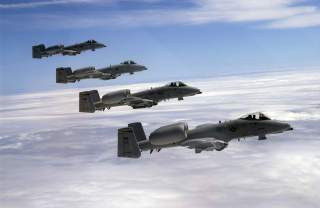Report: Human Error Was the Cause of 2017 A-10C Collision
We've got the details.
The service has already rewinged 173 A-10s (including one aircraft that has since crashed), but 109 Warthogs (one-third of the fleet) are still flying with their original wings and are in desperate need of wing set replacements or the USAF will be forced to start grounding them.
The U.S. Air Force (USAF) has recently determined the cause behind the collision of two A-10C Thunderbolt IIs over Nevada Test and Training Range (NTTR) in September 2017.
According to Air Combat Command Accident Investigation Board in fact on Sept 6, 2017, two A-10C attack aircraft collided over NTTR because their aircrews failed to adhere to established altitude and deconfliction procedures.
The pilots were conducting a night, close air support training mission as part of the Weapons Instructor Course qualification for pilot one with pilot two as the instructor of record when the incident occurred. Pilot one climbed above the assigned altitude block during a series of commands and did not hear the audible notification signaling the altitude climb and therefore did not radio-in to deconflict established altitude blocks. This caused pilot one’s aircraft to enter the altitude space designated for pilot two. Pilot two did not have line of sight on pilot one when the collision occurred. The midair collision rendered both aircraft uncontrollable and both pilots ejected.
In addition to unintentional failure to adhere to established altitude deconfliction procedures, investigators also found task over-saturation, misperception of changing environment, breakdown in visual scan and environmental conditions affecting vision to be other substantial contributing factors that led to this mishap.
Noteworthy as we have recently reported Congress passed a $1.3 trillion spending measure for fiscal 2018 that will allow the USAF to stand up a new production line for A-10 wings and buy the first four wing sets.
The service has already rewinged 173 A-10s (including one aircraft that has since crashed), but 109 Warthogs (one-third of the fleet) are still flying with their original wings and are in desperate need of wing set replacements or the USAF will be forced to start grounding them.
The A-10 is currently one of the U.S. military’s most utilized aircraft across multiple theaters, crucial in contingency operations against North Korea, Russian aggression in Eastern Europe, and ISIS in the Middle East.
The Thunderbolt II has excellent maneuverability at low air speeds and altitude, and is a highly accurate and survivable weapons-delivery platform. The aircraft can loiter near battle areas for extended periods of time and operate in low ceiling and visibility conditions. The wide combat radius and short takeoff and landing capability permit operations in and out of locations near front lines. Using night vision goggles (NVG), A-10 pilots can conduct their missions during darkness.
This article by Dario Leone originally appeared on The Aviation Geek Club in 2018.
Image: Wikimedia.

